How to Calculate Your Solar Energy Savings: A Step-by-Step Guide
Switching to solar energy is a smart choice for many homeowners and businesses. Solar power not only helps reduce your carbon footprint but also saves you money on electricity bills in the long run. However, before making the switch, many people wonder how much they can save by installing solar panels. In this guide, we’ll walk you through the step-by-step guide how to calculate your solar energy savings and explain how you can estimate your return on investment. Step 1: Understand Your Current Energy Consumption The first step in how to calculate your solar energy savings is to understand your current energy usage. You can find this information on your electricity bill, which typically shows your monthly energy consumption in kilowatt-hours (kWh). The more electricity you use, the greater your potential savings with solar power. For example, if your monthly electricity consumption is 500 kWh and you are charged ₹8 per kWh, your monthly electricity bill would be: 500 kWh x ₹8 = ₹4,000 per month This is the amount you could potentially reduce or eliminate with solar power. Step 2: Determine the Size of Your Solar System The size of the solar system you need depends on your energy consumption and the space available for installing solar panels. Typically, a 1 kW solar system generates about 4-5 kWh of electricity per day in India, depending on the location and weather conditions. To cover your monthly electricity needs of 500 kWh, you would need a system that generates at least 16.67 kWh per day. This can be calculated as: 500 kWh (monthly usage) ÷ 30 days = 16.67 kWh per day. For this requirement, you would need a 3.5 kW solar system (since 1 kW generates about 5 kWh per day). Step 3: Estimate the Cost of Solar Installation The solar installation cost in India varies depending on the type and quality of the panels, installation complexity, and other factors. In India, the average cost for a 1 kW solar system (on-grid) is around ₹45,000 to ₹60,000. Offgrid systems, which include batteries, can cost more. For a 3.5 kW system, the total cost would range from: ₹45,000 x 3.5 kW = ₹1,57,500 ₹60,000 x 3.5 kW = ₹2,10,000 This gives you an estimate of the initial investment needed to install solar panels for your home or business. Step 4: Calculate Government Incentives and Subsidies In India, the government offers various incentives and subsidies to encourage solar energy adoption. Under the Ministry of New and Renewable Energy (MNRE) scheme, residential and commercial installations can receive subsidies, reducing the upfront cost. Subsidies are usually provided for systems up to 10 kW, and the rates vary depending on the state. Typically, you can get a subsidy of 20% to 40% of the total installation cost. For a 3.5 kW system costing ₹1,57,500, a 30% subsidy would reduce your cost by: ₹1,57,500 x 0.30 = ₹47,250 Thus, after the subsidy, the actual cost would be: ₹1,57,500 – ₹47,250 = ₹1,10,250 This shows how how to calculate your solar energy savings and government subsidies can significantly reduce the cost of solar installation. Step 5: Estimate Your Solar Energy Production To calculate savings, you need to estimate how much electricity your solar system will generate. A 3.5 kW system in India generates approximately 4-5 kWh per kW per day, depending on sunlight exposure. For a 3.5 kW system, the average daily production would be: 3.5 kW x 4.5 kWh = 15.75 kWh per day Over a month (30 days), this would generate approximately: 15.75 kWh x 30 days = 472.5 kWh per month If your current electricity consumption is 500 kWh, the solar system would cover most of your energy needs, significantly reducing your electricity bills. Step 6: How much can you save with solar power in India Now, let’s calculate how much you’ll save on your monthly electricity bill. If your system generates 472.5 kWh per month and you’re charged ₹8 per kWh by your electricity provider, your savings would be: 472.5 kWh x ₹8 = ₹3,780 per month This means that your electricity bill, which was ₹4,000 per month before installing solar, will now be only around ₹220 per month (for the remaining 27.5 kWh from the grid). Over a year, your savings will be: ₹3,780 x 12 months = ₹45,360 per year Step 7: Calculate ROI for solar energy systems in India To calculate the return on investment (ROI), divide the total cost of installation by the annual savings. For example, if your system costs ₹1,10,250 after the subsidy and you save ₹45,360 per year, the payback period would be: ₹1,10,250 ÷ ₹45,360 = 2.43 years This means that within about 2.5 years, you’ll recover the initial investment, and after that, your electricity will be essentially free. Step 8: Factor in Maintenance Costs While solar panels require very little maintenance, it’s important to account for occasional cleaning and system checks. Maintenance costs in India are relatively low and typically range from ₹1,000 to ₹5,000 per year, depending on the size and complexity of the system. Even with these minor costs, your overall savings will still be substantial. Step 9: Consider Long-Term Savings Solar panels have a lifespan of 25 to 30 years, so your long-term savings will far exceed the initial investment. After the payback period, you will enjoy free or low-cost electricity for decades, which can lead to massive savings over the lifetime of the system. For example, if your annual savings are ₹45,360 and the panels last for 25 years, your total savings would be: ₹45,360 x 25 years = ₹11,34,000 Conclusion Calculating your solar energy savings is straightforward when you break it down step by step. By understanding your current energy consumption, the solar installation cost, and the potential savings, you can make an informed decision about whether solar power is right for you. With government subsidies, increasing electricity rates, and the long-term benefits of solar energy, the switch to solar is more attractive than ever. If you’re considering









